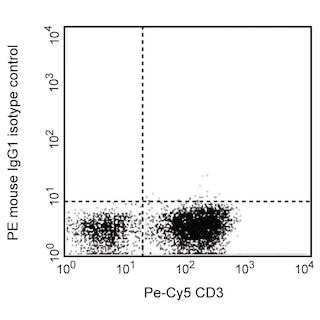-
Your selected country is
Middle East / Africa
- Change country/language
Old Browser
This page has been recently translated and is available in French now.
Looks like you're visiting us from {countryName}.
Would you like to stay on the current country site or be switched to your country?


.png)

Flow cytometric analysis of human podoplanin expression on human teratocarcinoma cell line. NCCIT cells (ATCC CRL-2073) were stained with either PE Mouse IgG1, κ Isotype Control (Cat. No. 554680, dashed line histogram) or PE Mouse Anti-Human Podoplanin (Cat. No. 566793, solid line histogram) at 1 µg/test. The fluorescence histogram showing podoplanin expression (or Ig Isotype control staining), was derived from gated events with the forward and side light-scatter characteristics of viable cells. Flow cytometry and data analysis were performed using a BD FACSCelesta™ Cytometer System and FlowJo™ software. Data shown on this Technical Data Sheet are not lot specific.
.png)

BD Pharmingen™ PE Mouse Anti-Human Podoplanin
.png)
Regulatory Status Legend
Any use of products other than the permitted use without the express written authorization of Becton, Dickinson and Company is strictly prohibited.
Preparation And Storage
Product Notices
- Since applications vary, each investigator should titrate the reagent to obtain optimal results.
- An isotype control should be used at the same concentration as the antibody of interest.
- Caution: Sodium azide yields highly toxic hydrazoic acid under acidic conditions. Dilute azide compounds in running water before discarding to avoid accumulation of potentially explosive deposits in plumbing.
- For fluorochrome spectra and suitable instrument settings, please refer to our Multicolor Flow Cytometry web page at www.bdbiosciences.com/colors.
- Please refer to http://regdocs.bd.com to access safety data sheets (SDS).
- Please refer to www.bdbiosciences.com/us/s/resources for technical protocols.
Companion Products



The LpMab-23 monoclonal antibody specifically recognizes a cancer-specific form of human podoplanin. Podoplanin is a 38-44 kDa type I transmembrane glycoprotein that is encoded by PDPN. This heavily glycosylated mucin type protein is named for its expression on kidney glomerular epithelial cells known as podocytes. Although the podoplanin protein is expressed on a wide variety of cell types in normal tissues (including placenta, lung, skeletal muscle and brain), LpMab-23 recognizes an altered glycosylation pattern that occurs on oral cancer cells and it shows minimal reactivity with the surrounding non-cancerous tissue. In contrast, the LpMab-17 monoclonal antibody recognizes a non-glycosylated epitope of podoplanin on normal and cancer cells. Podoplanin induces platelet aggregation via its three platelet aggregation-stimulating (PLAG) domains; it binds C-type lectin domain family 1 member B (Clec1B, also known as CLEC2); and it is involved in actin cytoskeleton organization and in cellular adhesion and migration. It also plays roles in organogenesis, vascular development, inflammatory diseases, tumorigenesis, and cancer cell motility and metastasis.

Development References (8)
-
Astarita JL, Acton SE, Turley SJ. Podoplanin: emerging functions in development, the immune system, and cancer.. Front Immunol. 2012; 3:283. (Biology). View Reference
-
Chang JE, Turley SJ. Stromal infrastructure of the lymph node and coordination of immunity. Trends Immunol.. 2015; 36(1):30-9. (Biology). View Reference
-
Dang Q, Liu J, Li J, Sun Y. Podoplanin: a novel regulator of tumor invasion and metastasis. Med Oncol. 2014; 31(9):24. (Biology). View Reference
-
Miyazaki A, Nakai H, Sonoda T, et al. LpMab-23-recognizing cancer-type podoplanin is a novel predictor for a poor prognosis of early stage tongue cancer. Oncotarget. 2018; 9(30):21156-21165. (Clone-specific: Immunohistochemistry). View Reference
-
Pan Y, Xia L. Emerging roles of podoplanin in vascular development and homeostasis. Front Med. 2015; 9(4):421-30. (Biology). View Reference
-
Retzbach EP, Sheehan SA, Nevel EM, et al. Podoplanin emerges as a functionally relevant oral cancer biomarker and therapeutic target. j.oraloncology. 2018; 78:126-136. (Clone-specific: Immunohistochemistry). View Reference
-
Ugorski M, Dziegiel P, Suchanski J. Podoplanin - a small glycoprotein with many faces. Am J Cancer Res. 2016; 6(2):370-86. (Biology). View Reference
-
Yamada S, Ogasawara S, Kaneko MK, Kato Y. LpMab-23: A Cancer-Specific Monoclonal Antibody Against Human Podoplanin. Monoclon Antib Immunodiagn Immunother. 2017; 36(2):72-76. (Immunogen: Flow cytometry, Immunohistochemistry). View Reference
Please refer to Support Documents for Quality Certificates
Global - Refer to manufacturer's instructions for use and related User Manuals and Technical data sheets before using this products as described
Comparisons, where applicable, are made against older BD Technology, manual methods or are general performance claims. Comparisons are not made against non-BD technologies, unless otherwise noted.
For Research Use Only. Not for use in diagnostic or therapeutic procedures.
Report a Site Issue
This form is intended to help us improve our website experience. For other support, please visit our Contact Us page.